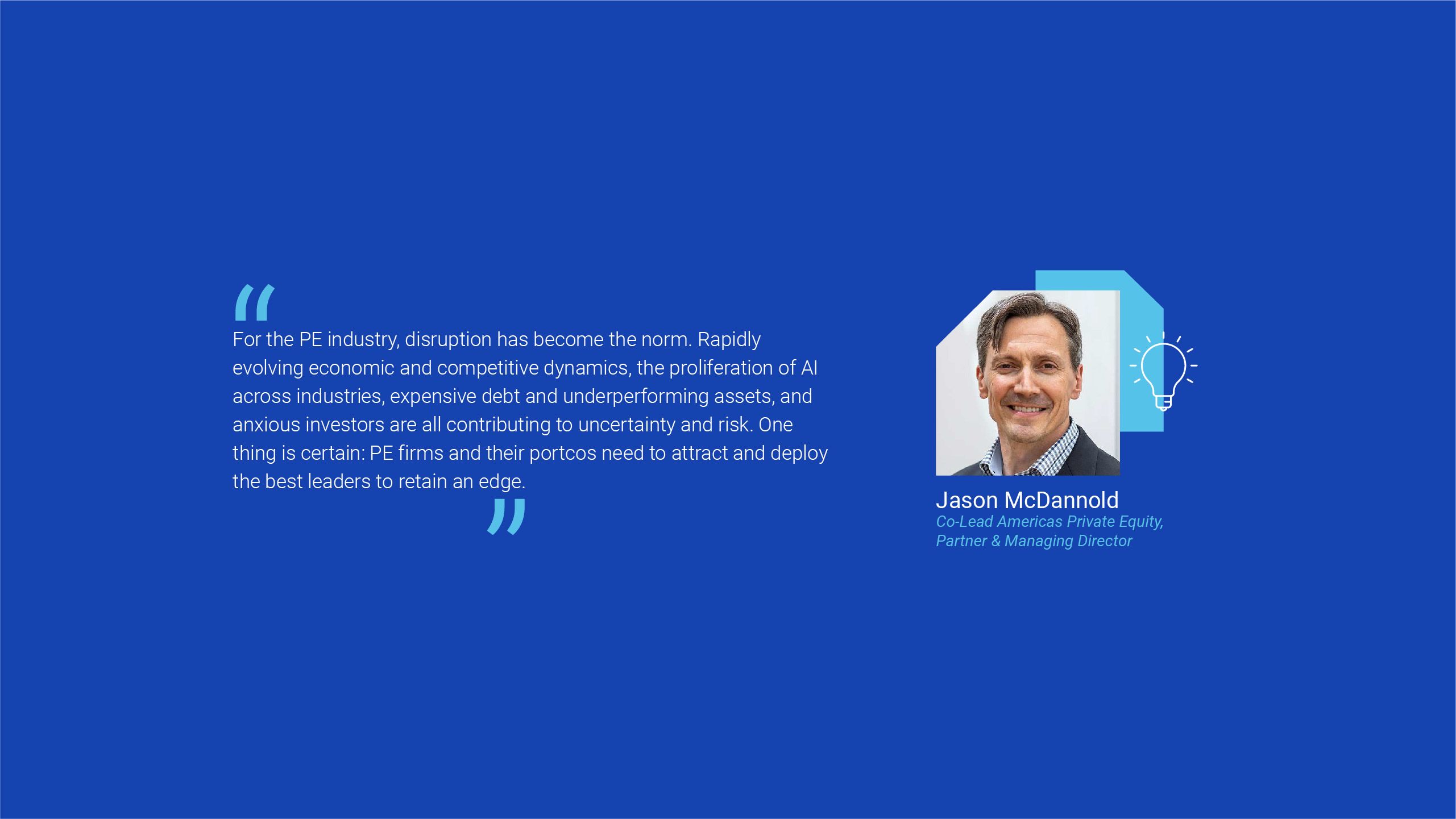LEADERSHIP AND
THE FUTURE OF VALUE CREATION
The new PE imperative

LEADERSHIP AND
THE FUTURE OF
VALUE CREATION
The new PE imperative

Coming out of a period of unprecedented turmoil, industry executives are focusing on achieving enterprise value milestones, meeting top-line growth goals, and protecting margins. They are also increasingly aware that those financial goals cannot be achieved with business-as-usual approaches. Talent and leadership are increasingly taking center stage in the pursuit of creating value. At the same time, however, many in the industry are uncertain about the best ways to attract, retain and deploy the leadership they need.
Disruption remains the name of the game, puts different pressures on leadership, and calls on different human capabilities.
Coming out of a period of unprecedented turmoil, industry executives are focusing on achieving enterprise value milestones, meeting top-line growth goals, and protecting margins. They are also increasingly aware that those financial goals cannot be achieved with business-as-usual approaches. Talent and leadership are increasingly taking center stage in the pursuit of creating value. At the same time, however, many in the industry are uncertain about the best ways to attract, retain and deploy the leadership they need.
Disruption remains the name of the game, puts different pressures on leadership, and calls on different human capabilities.
While talent recruitment, development and retention have remained both a challenge and a priority for PE executives and portfolio company leaders, survey respondents cite meeting milestones for enterprise value growth and accelerating topline growth among their biggest challenges for the year ahead.
Relationships between PE executives and portfolio company leaders overall are positive and constructive:
Almost all PE respondents report their relationships with their portco execs are the same or better as compared to the last three years
The vast majority of portco respondents report PE investors' impact on their business performance has stayed the same or improved over the last three years
PE survey respondents cite driving topline growth (56%) and meeting growth milestones (64%) among their biggest challenges for the year ahead.
But masked by the positive feedback are areas for improvement:
PE respondents cite a lack of urgency, unfocused execution strategies, and a lack of flexibility as the top three drivers of poor CXO performance
Portco respondents cited a lack of operational expertise, a clash in working styles, and insufficient capital as the primary challenges when dealing with investors over the last 12 months
While talent recruitment, development and retention have remained both a challenge and a priority for PE executives and portfolio company leaders, survey respondents cite meeting milestones for enterprise value growth and accelerating topline growth among their biggest challenges for the year ahead.
Relationships between PE executives and portfolio company
leaders overall are positive and constructive:
Almost all PE respondents report their relationships with their portco execs are the same or better as compared to the last three years
The vast majority of portco respondents report PE investors' impact on their business performance has stayed the same or improved over the last three years
PE survey respondents cite driving topline growth (56%) and meeting growth milestones (64%) among their biggest challenges for the year ahead.
But masked by the positive feedback are areas for improvement:
PE respondents cite a lack of urgency, unfocused execution strategies, and a lack of flexibility as the top three drivers of poor CXO performance
Portco respondents cited a lack of operational expertise, a clash in working styles, and insufficient capital as the primary challenges when dealing with investors over the last 12 months

Ninth Annual Private Equity (PE) Leadership Survey



KEY FINDING #1
Execution is job one. Performance pressure eased during the COVID-19 pandemic and as companies struggled with the transition to higher inflation and interest rates, but it’s pedal to the metal now: both portcos and PE firms say performance is the priority, and the presence of a large number of underperforming assets shows that the industry has a performance problem.
KEY FINDING #2
Significant areas of misalignment between PE firms and portcos—many of the issues having to do with leadership—create conflicting leadership agendas that could derail value creation plans.
KEY FINDING #3
Despite the PE Firms and portcos’ differences, underlying relationships between PE firms and portcos are generally positive and constructive. They have a sense of shared expectations and ownership, and the essential state of the union between investors and portcos is strong.
KEY FINDING #4
Though both parties say leadership is the key to sustained value creation, the PE industry is not taking steps to produce sustained leadership excellence. Key talent development practices are not widely followed, and best practices not agreed upon; most of the industry manages talent in transactional and traditional ways.
KEY FINDING #5
Technology—artificial intelligence in particular—is disrupting PE industry business models and reshaping the leadership agenda, with implications for where value is being created in organizations and by whom.
KEY FINDING #6
There is a critical need for PE firms and portcos to build on the strength of their relationship and work together more urgently to develop stronger change capabilities—tactically, strategically, technically, and culturally. Portcos in general need more operating support earlier.
AN AGENDA FOR ACTION
PE firms and portcos start from a good place, as the first key findings in this study document. They wholeheartedly agree on the importance and urgency of delivering superior value creation and business performance. And they believe they’re in this together, with a shared sense of ownership of the challenges they face—and the opportunities—and with a good amount of mutual trust.
We see six kinds of actions that together can elevate leadership practices with an eye specifically toward increasing enterprise value quickly.

AN AGENDA FOR ACTION
PE firms and portcos start from a good place, as the first key findings in this study document. They wholeheartedly agree on the importance and urgency of delivering superior value creation and business performance. And they believe they’re in this together, with a shared sense of ownership of the challenges they face—and the opportunities—and with a good amount of mutual trust.
We see six kinds of actions that together can elevate leadership practices with an eye specifically toward increasing enterprise value quickly.


AUTHORS
ABOUT OUR SURVEY
Each year, findings from the AlixPartners PE Leadership Survey deliver valuable insights on themes relevant to the success of PE investments. In previous years, themes we explored included:
- Key success factors in the first 100 days after a PE investment deal
- The impact of portcos’ human capital management practices on PE’s internal rates of return
- New imperatives that portco and PE leaders must meet during times of disruption
- The role of a portco’s organizational culture in investment performance
- Leadership capabilities for a new era of private equity value creation
This year’s survey was administered online from October through December 2023. Respondents consisted of 129 PE firm managing directors, operating partners or founders, and 56 portfolio company (portco) directors, the majority of whom are CEOs or CFOs. Seventy-five percent of the PE firm respondents are with companies based in North America, as are 89% of the portco respondents. The largest share of portco respondents (36%) were with companies registering annual revenues of $100 million to $500 million, with another 28% coming from companies with annual revenues of less than $100 million. 49% of PE firm respondents reported their firms’ assets under management as less than $5 billion; another 29% have assets under management (AUM) between $5 billion and $20 billion.
VIEW RESULTS FROM PREVIOUS YEARS' SURVEYS





























